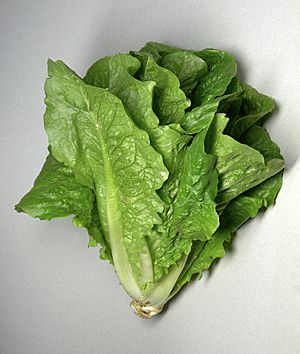Romaine lettuce facts for kids
Romaine or cos lettuce (Lactuca sativa L. var. longifolia) is a popular type of lettuce known for its long, sturdy leaves and crisp texture. It's a leafy green vegetable that adds a fresh crunch to many meals. Its flavor is a bit stronger and slightly more bitter than some other lettuce types, but it's still very refreshing. Romaine lettuce is special because it's one of the few kinds of lettuce that can be safely fed to iguanas as part of their diet.
Contents
What is Romaine Lettuce?
Romaine lettuce is a member of the daisy family, just like sunflowers! It grows in a tall, upright head with long, dark green leaves that have a strong rib down the center. These ribs are very crunchy, especially towards the bottom of the leaf. The name "cos lettuce" comes from the Greek island of Kos, where it was once very common.
How Romaine Lettuce Grows
Romaine lettuce is an annual plant, which means it completes its entire life cycle in one growing season. It starts from a tiny seed, grows into a full plant, produces its own seeds, and then dies. Farmers usually plant romaine lettuce in cool weather, either in spring or fall, because it doesn't like too much heat. It needs plenty of sunshine and water to grow big and healthy.
From Seed to Salad Bowl
When you plant a romaine seed, it first sprouts small leaves. As it grows, the leaves get longer and form a tight, upright head. Farmers harvest romaine lettuce by cutting the whole head from the ground. Sometimes, they might also pick just the outer leaves, allowing the inner leaves to continue growing. This way, they can get more harvests from one plant!
Why Romaine Lettuce is Good for You
Romaine lettuce is not just tasty; it's also packed with good things that help your body stay healthy. It's a low-calorie food, meaning you can eat a lot of it without getting too many calories.
Vitamins and Minerals in Romaine
- Vitamin K: This vitamin is super important for helping your blood clot when you get a cut. It also helps keep your bones strong.
- Vitamin A: Romaine lettuce has a lot of beta-carotene, which your body turns into Vitamin A. This vitamin is great for your eyesight, especially in dim light, and helps your immune system fight off sickness.
- Folate: Also known as Vitamin B9, folate helps your body make new cells and is important for growth.
- Fiber: Romaine lettuce contains dietary fiber, which helps your digestive system work smoothly and keeps you feeling full.
- Water: Like most lettuces, romaine is mostly water, which helps keep you hydrated.
How We Use Romaine Lettuce
Romaine lettuce is very versatile and can be used in many different dishes. Its crisp texture and mild flavor make it a favorite for salads and sandwiches.
Popular Romaine Dishes
- Caesar Salad: This is probably the most famous dish made with romaine lettuce! It's a classic salad with croutons, Parmesan cheese, and a creamy Caesar dressing. The sturdy leaves of romaine hold up well to the dressing without getting soggy.
- Salads: Beyond Caesar, romaine is a great base for any kind of salad. You can add your favorite vegetables, proteins, and dressings.
- Wraps and Sandwiches: Instead of bread, you can use large romaine leaves to wrap up fillings like chicken, tuna, or vegetables for a light and crunchy meal.
- Grilled Romaine: Yes, you can grill lettuce! Grilling romaine gives it a slightly smoky flavor and a tender-crisp texture. It's often served with a light dressing.
Images for kids
See also
 In Spanish: Lechuga romana para niños
In Spanish: Lechuga romana para niños




